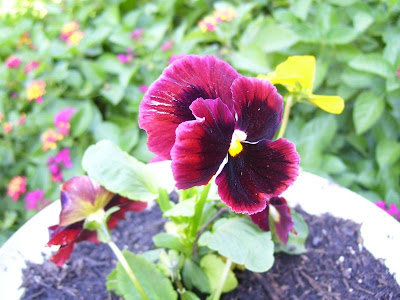In the perennial category, there is a two-way tie for the win. First up is Arizona Sun gaillardia. This plant brightened up the flower bed from mid-spring all the way till now and is still going. It has never been without blooms and is in a bed where I don't have irrigation. It's taken all nature can throw at it and kept on smiling.
The other winner is lantana. I'm not breaking it down into varieties because all three of my lantana varieties did equally well. They too have bloomed from mid-spring on and with little to no care at all. Above is Ham and Eggs.
The lantanas bloom like crazy and are never without the constant buzz of insect and hummingbird wings. Above is a mix of Miss Huff and (I think) Dallas Red.
In the annual category we have a surprise winner. I didn't even plant this vinca, but it hasn't taken this slight to heart and has performed through heat and drought without a blink. I've never watered it and it has happily bloomed away from it's crack in the concrete. It is constantly covered in bloom and has a very pleasant form. No other annual in my yard has looked this good for such a long time. Next year I will definitely plant a bunch of these.
In the shrub category, a couple of roses share the honor. None of my other shrubs bloom as often or as long as these roses. Above is Earthsong. It keeps large blooms even in the heat of summer, gets no disease, has a pleasant fragrance, and asks for little care. It has almost never been without at least a couple of blooms.
Belinda's Dream has a similar description. Huge blooms, nice fragrance, pleasing bush form, no disease, and carefree. It puts on a new flush of blooms at least once per month and the blooms are not diminished by heat. It has not been touched by blackspot, even without fungicide.
Honorable mention in the shrub category goes to my Royal Red buddleia ("butterfly bush.") It has also bloomed all year, spreading sweet fragrance to people and sweet nectar to butterflies and hummingbirds for the duration. I don't have a decent picture of it to post here.
In the tree category, the winner is my Chaste Vitex tree. Such lovely flowers, interesting foliage, a pleasing form, and sweet fragrance. I also love that it attracts the friendly flyers that I delight to see.














+10-26-10.jpg)
+10-27-10.jpg)
+10-27-10.jpg)




+10-10-10.jpg)
















+10-06-10.jpg)


+10-04-10.jpg)
+10-01-10.jpg)






+09-30-10.jpg)
+09-30-10.jpg)